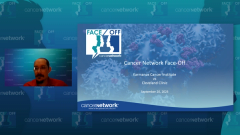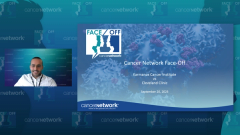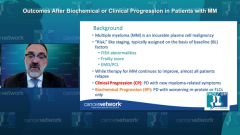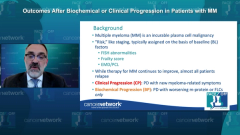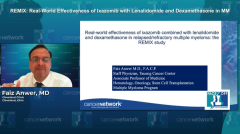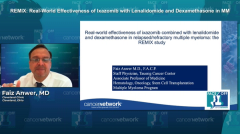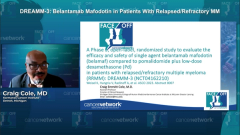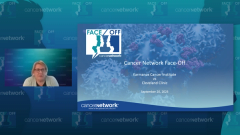
CARTITUDE-4: Cilta-Cel in Lenalidomide-Refractory MM
Jack Khouri, MD, discusses phase 3 results from the CARTITUDE-4 study investigating ciltacabtagene autoleucel in patients with lenalidomide-refractory multiple myeloma.
Episodes in this series

Transcript:
Judy Schreiber, PhD, RN: Let’s move on to the next abstract that will be presented by Dr Khouri, which is related to the CARTITUDE-4 study [NCT04181827].
Jack Khouri, MD: There are more exciting data on cilta-cel [ciltacabtagene autoleucel]. I’ll be presenting the results of the phase 3 CARTITUDE-4 study of cilta-cel vs standard of care with PVd [pomalidomide, bortezomib, dexamethasone] or DPd [daratumumab, pomalidomide, dexamethasone] in lenalidomide-refractory multiple myeloma [MM].
Ciltacabtageneautoleucel CAR [chimeric antigen receptor] T-cell therapy has already been approved for myeloma and has current approval in the United States. [It] is for patients with relapsed or refractory myeloma who have received at least 4 prior lines of treatment, including a proteasome inhibitor, an IMiD [immunomodulatory drug], and an anti-CD38 antibody. And as you can see in the picture here, cilta-cel is different from other types of CAR T cells because it has a better affinity to the BCMA [B-cell maturation antigen] target. It has 2 binding domains, which we think is part of the reason why it’s effective in [managing] this disease.
This is basically how cilta-cel has been evolving overall in myeloma. Initially, we started with the LEGEND-2 [NCT03090659] study in China, and the results were fantastic. And then the chain of studies started with CARTITUDE-1 [NCT03548207]. That included 97 patients, and [findings] showed a response rate of 98% in the heavily pretreated population of patients [with] myeloma with at least 3 prior lines of therapy. That led to the approval of cilta-cel for this patient population. Since then, we’ve had multiple studies that have looked at cilta-cel in different settings of myeloma, and one of them is CARTITUDE-4, which we’ll talk about in the next slides.
CARTITUDE-4was a phase 3 randomized controlled trial of ciltacabtageneautoleucel vs the standard of care in patients with early relapse. Patients who had received 1 to 3 prior lines of therapy were [randomly assigned] to either CAR [T-cell therapy] or standard of care with either a daratumumab-based regimen or pomalidomide, bortezomib, and dexamethasone, which are pretty commonly used in this early relapse setting. All the patients should have [had] lenalidomide-refractory [disease]. The primary end point was progression-free survival [PFS].
After apheresis, or after a collection of cells, patients were [randomly assigned] to either study’s drugs, so CAR [T-cell therapy] or dara/pom/dex [daratumumab, pomalidomide, dexamethasone] or pom/Velcade/dex [pomalidomide, bortezomib, dexamethasone] and the cilta-cel infusion. Cilta-cel was infused within 7 days after lymphodepletion, which was done with fludarabine and cyclophosphamide. The center-of-care arm patients received either regimen until progression.
Four hundred nineteen patients were [randomly assigned], with about 200 patients in each arm. More patients received DPd than PVd, which is a common standard practice. There were no manufacturing failures. The median dose was 0.71-mg/kg, which is typical; the doses are usually between 0.5 and 1 mg/kg. In terms of patient characteristics, they were well balanced, with about 60% of the patients in each arm having high-risk cytogenetics and 20% [having] anti-CD38 monoclonal antibody–refractory [disease].
These Kaplan-Meier [graphs] show PFS, so the primary end point. As you can see, it’s obvious that the PFS was much better with cilta-cel, which is the upper curve where the median PFS was not reached. The median PFS was close to a year for the center-of-care arm, and the hazard ratio was very impressive at 0.26.
The response rate was also higher for the CAR [T-cell] arm, with 85% vs 67%. There were more complete responses with CAR [T-cell therapy], with 73% vs 22%, and more MRD [minimal residual disease]-negative [result] rates as well. The 12-month PFS was 76% for cilta-cel and about 50% for the standard of care.
For safety, there were a lot of grade 3 and grade 4 AEs [adverse events], mostly infections and cytopenias. CRS [cytokine release syndrome] was mostly mild grade. We did see less CRS here in the earlier-line treatments. Fewer patients had CRS compared with the 95% rate of CRS that we see in people who are more heavily pretreated, and mostly [it was] grade 1 and grade 2 CRS. There were fewer [cases of] ICANS [immune effector cell-associated neurotoxicity syndrome], with 5% as opposed to 18% to 20% in the more heavily pretreated population. There was 1 patient who had a grade 1 movement disorder, which is something that we’ve seen in some patients whom we’ve given cilta-cel to. All in all, it was better tolerated in terms of CRS and ICANS, but we did see infections and cytopenias.
Transcript is AI-generated and edited for clarity and readability.
Newsletter
Stay up to date on recent advances in the multidisciplinary approach to cancer.


